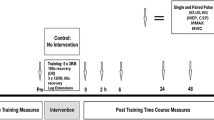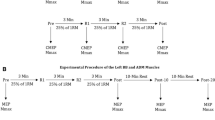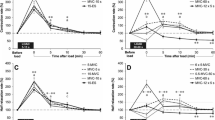Abstract
Post-activation potentiation (PAP), described as a muscular phenomenon, refers to the enhancement of contractile properties following a voluntary or electrically stimulated short duration (< 10 s) high-intensity contraction. Mechanistic factors and subsequent effects on voluntary performance have been well documented. Associations between neural activation and PAP, however, are less understood and systematically have not been explored. Thus, the aim is to critically summarize the current understanding of PAP regarding the motor pathway from the corticospinal tract to spinal level factors including the H-reflex and motor unit activation. This review highlights aspects for further investigation by providing an integrative summary of the relationship between PAP and neural control. Contractile history affects neural control in subsequent contractions, (e.g. fatiguing tasks), however, by contrast acute contractile enhancement due to PAP in relation to neural responses are not well-studied. From the limited number of investigations, motor unit discharge rates are reduced subsequent to PAP and, although less consistently reported, generally H-reflexes are depressed. Additionally, corticomedullary evoked potentials are depressed and the cortical silent period is elongated. Thus, overall there is a depression of spinal and supraspinal responses following PAP. Although specific factors responsible and their pathways are unclear, this down-regulation may occur to conserve neural activation when muscle contraction is more responsive, and concurrently a strategy used to delay neuromuscular fatigue. Indeed, the co-existence of PAP and fatigue is not a novel concept, but the interactions between PAP and neural responses are not understood and likely are more than coincidental.

Similar content being viewed by others
Abbreviations
- Ca2 + :
-
Calcium
- CaM:
-
Calmodulin
- CC:
-
Conditioning contraction
- CMEP:
-
Cervicomedullary motor evoked potential
- LG:
-
Lateral gastrocnemius
- MEP:
-
Motor evoked potential
- MU:
-
Motor unit
- MUDRs:
-
Motor unit discharge rates
- NME:
-
Neuromuscular efficiency
- PAP:
-
Post-activation potentiation
- PAPE:
-
Post-activation performance enhancement
- PSI:
-
Presynaptic inhibition
- RLC:
-
Regulatory myosin light chain
- skMLCK:
-
Skeletal myosin light chain kinase
- SP:
-
Silent period
- TMS:
-
Transcranial magnetic stimulation
- TMES:
-
Transmastoid electrical stimulation
References
Aboodarda SJ, Copithorne DB, Pearcey GE, Button DC, Power KE (2015) Changes in supraspinal and spinal excitability of the biceps brachii following brief, non-fatiguing submaximal contractions of the elbow flexors in resistance-trained males. Neurosci Lett 607:66–71. https://doi.org/10.1016/j.neulet.2015.09.028
Ali A, Sabbahi MA (2001) Test-retest reliability of the soleus H-reflex in three different positions. Electromyogr Clin Neurophysiol 41(4):209–214
Angel RW, Hofmann WW (1963) The H Reflex in normal, spastic, and rigid subjects. Arch Neurol 8(6):591–596. https://doi.org/10.1001/archneur.1963.00460060021002
Balbi PA, Perretti A, Sannino M, Marcantonio L, Santoro L (2002) Postexercise facilitation of motor evoked potentials following transcranial magnetic stimulation: a study in normal subjects. Muscle Nerve 25:448–452. https://doi.org/10.1016/j.clinph.2004.03.028
Baudry S, Duchateau J (2004) Postactivation potentiation in human muscle is not related to the type of maximal conditioning contraction. Muscle Nerve 30:328–336. https://doi.org/10.1002/mus.20101
Berardelli A, Inghilleri M, Rothwell JC, Manfredi M (1991) Multiple firing of motoneurones is produced by cortical stimulation but not by direct activation of descending motor tracts. Electroencephalogr Clin Neurophysiol 81:240–242. https://doi.org/10.1016/0168-5597(91)90078-C
Blazevich AJ, Babult (2019) Post-activation potentiation versus post-activation performance enhancement in humans: historical perspective, underlying mechanisms, and current issues. Front Physiol 10:1359. https://doi.org/10.3389/fphys.2019.01359
Boullosa D, Beato M, Dello Iacono A, Cuenca-Fernandez DK, Schumann M, Moura Zagatto A, Loturco I, Behm D (2020) A new taxonomy for post-activation potentiation in sport. Int J Sports Physiol Performance 19:1–14
Burke D, Gandevia SC, McKeon B (1984) Monosynaptic and oligosynaptic contributions to human ankle jerk and H-reflex. J Neurophysiol 52(3):435–448. https://doi.org/10.1152/jn.1984.52.3.435
Christie A, Inglis J, Kamen G, Gabriel DA (2009) Relationships between surface EMG variables and motor unit firing rates. Eur J Appl Physiol 107:177–1851. https://doi.org/10.1007/s00421-009-1113-7
Collins BW, Gale LH, Buckle NM, Button DC (2017) Corticospinal excitability to the biceps brachii and its relationship to postactivation potentiation of the elbow flexors. Physiol Rep. https://doi.org/10.14814/phys2.13265
DeLuca CJ, Foley PJ, Erim Z (1996) Motor unit control properties in constant-force isometric contractions. J Neurophysiol 75(3):1503–1516. https://doi.org/10.1152/jn.1996.76.3.1503
Enoka RM, Hutton RS, Eldred E (1980) Changes in excitability of tendon tap and Hoffmann reflexes following voluntary contractions. Electroencephalogr Clin Neurophysiol 48(6):663–672. https://doi.org/10.1016/0013-4694(80)90423-X
Folland JP, Wakamatsu T, Fimland MS (2008) The influence of maximal isometric activity on twitch and H-reflex potentiation, and quadriceps femoris performance. Eur J Appl Physiol 104(4):739–748. https://doi.org/10.1007/s00421-008-0823-6
Funase K, Miles TS (1999) Observations on the variability of the H reflex in human soleus. Muscle Nerve 22(3):341–346. https://doi.org/10.1002/(SICI)1097-4598(199903)22:3%3c341::AID-MUS6%3e3.0.CO;2-R
Gandevia SC (1998) Neural control in human muscle fatigue: changes in muscle afferents, moto neurones and moto cortical drive. Acta Physiol Scand 162:275–283. https://doi.org/10.1046/j.1365-201X,1998.0299f.x
Gandevia SC (2001) Spinal and supraspinal factors in human muscle fatigue. Physiol Rev 81(4):1725–1789. https://doi.org/10.1152/physrev.2001.81.4.1725
Gandevia SC, Allen GM, Butler JE, Taylor JL (1996) Supraspinal factors in human muscle fatigue: evidence for suboptimal output from the motor cortex. J Physiol 490:529–536. https://doi.org/10.1113/jphysiol.1996.sp021164
Gandevia SC, Petersen N, Butler JE, Taylor JL (1999) Impaired response of human motoneurones to corticospinal stimulation after voluntary exercise. J Physiol 521:749–759. https://doi.org/10.1111/j.1469-7793.1999.00749.x
Grange RW, Vandenboom R, Houston ME (1993) Physiological significance of myosin phosphorylation in skeletal muscle. Can J Appl Physiol 18(3):229–242. https://doi.org/10.1139/h93-020
Güillich A, Schmidtbleicher D (1996) MVC-induced short-term potentiation of explosive force. New Stud Athletics 11(4):67–84
Hallett M (2007) Transcranial magnetic stimulation: a primer. Neuron 55(2):187–199. https://doi.org/10.1016/j.neuron.2007.06.026
Hamada T, Sale G, MacDougall JD, Tarnopolsky MA (2003) Interaction of fibre type, potentiation and fatigue in human knee extensor muscles. Acta Physiol Scand 178(2):165–173. https://doi.org/10.1046/j.1365-201x.2003.01121.x
Henneman E, Mendell LM (1981) Functional organization of motoneuron pool and its inputs. In: Brooks VB (ed) Handbook of physiology section I, the nervous system. Am Physiol Soc, Bethesda, pp 423–508
Hodgson MJ, Docherty D, Zehr PE (2008) Post-activation potentiation of force is independent of h-reflex excitability. Int J Sports Physiol Perform 3(2):585–595
Hoffmann P (1918) Uber diebeziehungen der sehnenreflexe zur willurlichen bewegung und zumtonus. Z Biol 68:351–370
Hoffmann P, Zur Kenntnis B (1910) Reflex emit besonderer berucksichtigung der eletrischen erscheinungen. Arch Anat Physiol 1:223–246
Houston ME, Grange RW (1991) Torque potentiation and myosin light-chain phosphorylation in human muscle following a fatiguing contraction. Can J Physiol Pharmacol 69:269–273 https:// doi.org/https://doi.org/10.1139/y91-041
Hugon M (1973) Methodology of the Hoffman reflex in man. In: Desmedt JE (ed) New developments in electromyography and clin neurophysiol. Karger, Basel, pp 273–293
Iglesias-Soler E, Paredes X, Carballeria E, Marquez G, Fernandez-Del-Olmo M (2011) Effect of intensity and duration of conditional protocol on post-activation potentiation and changes in H-reflex. Eur J Sport Sci 11(1):33–38. https://doi.org/10.1080/17461391003770517
Inglis JG, Howard J, McIntosh K, Gabriel DA, Vandenboom R (2011) Decreased motor unit discharge rate in the potentiated human tibialis anterior muscle. Acta Physiol 201(4):483–492. https://doi.org/10.1111/j.1748-1716.2010.02233.x
Jackson A, Baker SN, Fetz EE (2006) Tests for presynaptic modulation of corticospinal terminals from peripheral afferents and pyramidal tract in the macaque. J Physiol 573:107–120. https://doi.org/10.1113/jphysiol.2005.100537
Klein CS, Ivanova TD, Rice CL, Garland SJ (2001) Motor unit discharge rate following twitch potentiation in human triceps brachii muscle. Neurosci Lett 316:153–156. https://doi.org/10.1016/S0304-3940(01)02389-8
Kudina LP, Aleexeeva NL (1992) After-potentials and control of repetitive firing in human motoneurones. Electroencephalogr Clin Neurophysiol 85(5):345–353. https://doi.org/10.1016/0168-5597(92)90139-3
Levine RJ, Chantler PD, Kensler RW, Woodhead KL (1991) Effects of phosphorylation by myosin light chain kinase on the structure of limulus thick filaments. J Cell Biol 113(3):563–572. https://doi.org/10.1083/jcb.113.3.563
Levine RJ, Kensler RW, Yang ZH, Stull JH, Sweeney HL (1996) Myosin light chain phosphorylation affects the structure of rabbit skeletal muscle thick filaments. Biophys J 71(2):898–907. https://doi.org/10.1016/S0006-3495(96)79293-7
MacIntosh BR, Gardiner PF (1987) Posttetanic potentiation and skeletal muscle fatigue: interactions with caffeine. Can J Physiol Pharmacol 65(2):260–280. https://doi.org/10.1139/y87-046
Magladery J, McGougal DB Jr (1950) Electrophysiological studies of nerve and reflex activity in normal man. I. Identification of certain reflexes in the electromyogram and the conduction velocity of peripheral nerve fibers. Bull Johns Hopkins Hosp 86(5):265–290
Manning DR, Stull JT (1979) Myosin light chain phosphorylation and phosphorylase a activity in rat extensor digitorum longus muscle. Biochem Biophys Res Commun 90(12):164–170. https://doi.org/10.1016/0006-291X(79)91604-8
Manning GDR, Stull JT (1982) Myosin light chain phosphorylation-dephosphorylation in mammalian skeletal muscle. Am J Physiol 242(3):C234-241. https://doi.org/10.1152/ajpcell.1982.242.3.c234
Martin PG, Butler JE, Gandevia SC, Taylor JL (2008) Noninvasive stimulation of human corticospinal axons innervating leg muscles. J Neurophysiol 100:1080–1086. https://doi.org/10.1152/jn.90380.2008
Martin PG, Huson AL, Gandevia SC, Taylor JL (2009) Reproducible measurement of human motoneuron excitability with magnetic stimulation of the corticospinal tract. J Neurophysiol 102:606–613. https://doi.org/10.1152/jn.91348.2008
McNeil CJ, Giesebrecht S, Khan SI, Gandevia SC, Taylor JL (2009) The reduction in human motoneurone responsiveness during muscle fatigue is not prevented by increased muscle spindle discharge. J Physiol 589:3731–3738. https://doi.org/10.1113/jphysiol.2011.210252
McNeil CJ, Butler JE, Taylor JL, Gandevia SC (2013) Testing the excitability of human motoneurons. Front Hum Neurosci 7:152. https://doi.org/10.3389/fnhum.2013.00152
Moore RL, Stull JT (1984) Myosin light chain phosphorylation in fast and slow twitch skeletal muscles in situ. Am J Physiol 247(5Pt1):C462–C471. https://doi.org/10.1152/ajpcell.1984.247.5.c462
Nielsen J, Petersen N (1994) Is presynaptic inhibition distributed to corticospinal fibres in man? J Physiol 477:47–58. https://doi.org/10.1113/jphysiol.1994.sp020170
Norgaard PJ, Nielsen JF, Andersen H (2000) Post-exercise facilitation of compound muscle action potentials evoked by transcranial magnetic stimulation in healthy subjects. Exp Brain Res 132:517–522. https://doi.org/10.1007/s002219900318
Pereschini A, Stull JT, Cooke R (1985) The effect of myosin phosphorylation on contractile properties of skinned rabbit skeletal muscle fibers. J Biol Chem 260(13):7951–7954
Person RS, Kozhina GV (1978) Investigation of the silent period by a poststimulus histogram method. Neurophysiol 10:123–129
Peterson NT, Taylor JL, Butler JE, Gandevia SC (2003) Depression of activity in the corticospinal pathway during human motor behaviour after strong voluntary contractions. J Neurosci 23:7974–7980. https://doi.org/10.1523/JNEUROSCI.23-22-07974.2003
Pierrot-Deseilligny E (1997) Assessing changes in presynaptic inhibition of Ia afferents during movment in humans. J Neurosci Methods 74:189–199. https://doi.org/10.1016/S0165-0270(97)02249-8
Pierrot-Deseilligny E, Mazevet D (2000) The monosynaptic reflex: a tool to investigate motor control in humans. Interest and limits Neurophysiol 30(2):67–80. https://doi.org/10.1016/S0987-7053(00)00062-9
Rassier DE, MacIntosh BR (2000) Coexistence of potentiation and fatigue in skeletal muscle. Braz J Med Biol Res 33:499–508. https://doi.org/10.1590/S0100-879X2000000500003
Rudomin P, Schmidt RF (1999) Presynaptic inhibition in the vertebrate spinal cord revisted. Exp Brain Res 129:1–37. https://doi.org/10.1007/s002210050933
Sale DG (2002) Postactivation potentiation: role in human performance. Exerc Sport Sci Rev 30(3):138–143. https://doi.org/10.1097/00003677-200207000-00008
Samii A, Wassermann EM, Ikoma K, Mercuri B, Hallett M (1996) Characterization of postexercise facilitation and depression of motor evoked potentials to transcranial magnetic stimulation. Neurology 46:1376–1382. https://doi.org/10.1212/WNL.46.5.1376
Seitz LB, Mina MA, Haff GG, Blazevich AJ (2015) Postactivation potentiation during voluntary contractions after continued knee extensor task-specific practice. Appl Physiol Nutr Metab 40:230–237. https://doi.org/10.1139/apnm-2014-0377
Smith CB, Cheng AJ, Rice CL (2011) Potentiation of the triceps brachii during voluntary submaximal contractions. Muscle Nerve 43:859–865. https://doi.org/10.1002/mus.21993
Smith CB, Allen MD, Rice CL (2020) Coexistence of peripheral potentiation and corticospinal inhibition following a conditioning contraction in human first dorsal interosseous muscle. J Appl physiol 129:926–931. https://doi.org/10.1152/japplphysiol.00238.2020
Svensson P, Miles TS, McKay D, Ridding MC (2003) Suppression of motor evoked potentials in hand muscle following prolonged painful stimulation. Eur J Pain 7:55–62. https://doi.org/10.1016/S1090-3801(02)00050-2
Sweeney HL, Bowman BF, Stull JT (1993) Myosin light chain phosphorylation in vertebrate striated muscle: regulation and function. Am J Physiol. https://doi.org/10.1152/ajpcell.1993.264.5.C1085
Taylor JL, Gandevia SC (2008) A comparison of central aspects of fatigue in submaximal and maximal voluntary contractions. J Appl Physiol 104:542–550. https://doi.org/10.1152/japplphysiol.01053.2007
Taylor JL, Petersen NT, Butler JE, Gandevia SC (2002) Interaction of transcranial magnetic stimulation and electrical transmastoid stimulation in human subjects. J Physiol 541:949–958. https://doi.org/10.1113/jphysiol.2002.016782
Taylor JL, Amann M, Duchateau J, Messusen R, Rice CL (2016) Neural contributions to muscle fatigue: from the brain to the muscle and back again. Med Sci Sports Exerc 48(11):2294–2306. https://doi.org/10.1016/S0304-3940(01)02389-8
Tillin NA, Bishop D (2009) Factors modulating post-activation potentiation and its effect on performance of subsequent explosive activities. Sports Med 39(2):147–166. https://doi.org/10.2165/00007256-200939020-00004
Trimble MH, Harp SS (1998) Post exercise potentiation of the h-reflex in humans. Med Sci Sports Exerc 30(6):933–941. https://doi.org/10.1097/00005768-199806000-00024
Tucker KJ, Türker (2004) Muscle spindle feedback differs between the soleus and gastrocnemius in humans. Somatoses Mot Res 21(3–4):189–197. https://doi.org/10.1080/08990220400012489
Ugawa Y, Rothwell JC, Day BL, Thompson PD, Marsden CD (1991) Percutaneous electrical stimulation of corticospinal pathways at the level of the pyramidal decussation in humans. Ann Neurol 29:418–427
Vandenboom R, Grange RW, Houston ME (1993) Threshold for force potentiation associated with skeletal myosin phosphorylation. Am J Physiol 265(6):C1456–C1462. https://doi.org/10.1152/ajpcell.1993.265.6.c1456
Vanderah T, Gould D (2015) Nolte’s the human brain. Elsevier, PA
Vandervoort AA, Quinlan J, McComas AJ (1983) Twitch potentiation after voluntary contraction. Exp Neurol 81:141–152. https://doi.org/10.1016/0014-4886(83)90163-2
Wallace BJ, Shapiro R, Wallace KL, Symons MG, Thorburn B (2019) Muscular and neural contributions to postactivation potentiation. J Strength Cond Res 33(3):615–625. https://doi.org/10.1519/JSC.0000000000003011
Wolters A, Ziemann U, Benecke R (2008) The oxford handbook of transcranial stimulation. Oxford University Press Inc, New York, pp 91–102
Xenofondos A, Dimitrios P, Kotzamanidis C (2014) On the mechanisms of post-activation potentiation: the contribution of neural factors. J Phys Ed Sport 14(21):134–137. https://doi.org/10.7752/jpes.2014.02021I
Xenofondos A, Patikas D, Koceja DM, Behdad T, Bassa E, Eleftherios K, Kotzamanidis (2015) Post-activation potentiation: the neural effects of post-activation depression. Muscle Nerve 52:252–259. https://doi.org/10.1002/mus.24533
Zehr PE (2002) Considerations for the use of the Hoffmann reflex in exercise studies. Eur J Appl Physiol 86:455–468. https://doi.org/10.1007/s00421-002-0577-5
Zimmermann HB, MacIntosh BR, Dal Pupo J (2019) Does postactivation potentiation (PAP) increase voluntary performance? Appl Physiol Nutr Metab 45(4):349–356. https://doi.org/10.1139/apnm-2019-0406
Funding
This research was supported by the Natural Sciences and Engineering Research Council of Canada (NSERC) (Grant no. 180970) as well as an Ontario Graduate Scholarship (OGS).
Author information
Authors and Affiliations
Corresponding author
Ethics declarations
Conflict of interest
AM Zero and CL Rice have no conflicts of interest relevant to the content in this article.
Additional information
Communicated by Michael Lindinger.
Publisher's Note
Springer Nature remains neutral with regard to jurisdictional claims in published maps and institutional affiliations.
Rights and permissions
About this article
Cite this article
Zero, A.M., Rice, C.L. State-of-the-art review: spinal and supraspinal responses to muscle potentiation in humans. Eur J Appl Physiol 121, 1271–1282 (2021). https://doi.org/10.1007/s00421-021-04610-x
Received:
Accepted:
Published:
Issue Date:
DOI: https://doi.org/10.1007/s00421-021-04610-x




